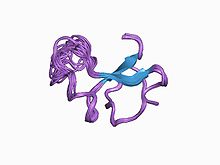Insulin-like growth factor-binding protein
In today's world, Insulin-like growth factor-binding protein is a topic that has captured the attention of a large number of people. With its relevance in our contemporary society, Insulin-like growth factor-binding protein is a topic that undoubtedly arouses the interest of people of all ages, genders and cultures. Insulin-like growth factor-binding protein has been the subject of numerous studies, debates and discussions, and its importance continues to increase. In this article, we will thoroughly explore the impact and relevance of Insulin-like growth factor-binding protein in our daily lives, examining its different aspects and its influence in various areas.
| Insulin-like growth factor binding protein | |||||||||||
|---|---|---|---|---|---|---|---|---|---|---|---|
 Structure of the IGF-binding domain of the insulin-like growth factor-binding protein-5 (IGFBP-5) | |||||||||||
| Identifiers | |||||||||||
| Symbol | IGFBP | ||||||||||
| Pfam | PF00219 | ||||||||||
| InterPro | IPR000867 | ||||||||||
| SMART | SM00121 | ||||||||||
| PROSITE | PDOC00194 | ||||||||||
| SCOP2 | 1boe / SCOPe / SUPFAM | ||||||||||
| |||||||||||
The insulin-like growth factor-binding protein (IGFBP) serves as a transport protein for insulin-like growth factor 1 (IGF-1).
Function
Approximately 98% of IGF-1 is always bound to one of six binding proteins (IGF-BP). IGFBP-3, the most abundant protein, accounts for 80% of all IGF binding. IGF-1 binds to IGFBP-3 in a 1:1 molar ratio. IGF-BP also binds to IGF-1 inside the liver, allowing growth hormone to continuously act upon the liver to produce more IGF-1.
IGF binding proteins (IGFBPs) are proteins of 24 to 45 kDa. All six IGFBPs share 50% homology with each other and have binding affinities for IGF-I and IGF-II at the same order of magnitude as the ligands have for the IGF-IR.
The IGFBPs help to lengthen the half-life of circulating IGFs in all tissues, including the prostate. Individual IGFBPs may act to enhance or attenuate IGF signaling depending on their physiological context (i.e. cell type). Even with these similarities, some characteristics are different: chromosomal location, heparin binding domains, RGD recognition site, preference for binding IGF-I or IGF-II, and glycosylation and phosphorylation differences. These structural differences can have a tremendous impact on how the IGFBPs interact with cellular basement membranes.
Family members
In humans, IGFBPs are transcribed from the following seven genes:
See also
References
- ^ Kalus W, Zweckstetter M, Renner C, et al. (November 1998). "Structure of the IGF-binding domain of the insulin-like growth factor-binding protein-5 (IGFBP-5): implications for IGF and IGF-I receptor interactions" (PDF). EMBO J. 17 (22): 6558–72. doi:10.1093/emboj/17.22.6558. PMC 1171003. PMID 9822601.
- ^ Hwa V, Oh Y, Rosenfeld RG (December 1999). "The insulin-like growth factor-binding protein (IGFBP) superfamily". Endocr. Rev. 20 (6): 761–87. doi:10.1210/edrv.20.6.0382. PMID 10605625.
- ^ Clemmons DR, Busby WH, Arai T, Nam TJ, Clarke JB, Jones JI, Ankrapp DK (1995). "Role of insulin-like growth factor binding proteins in the control of IGF actions". Prog. Growth Factor Res. 6 (2–4): 357–66. doi:10.1016/0955-2235(95)00013-5. PMID 8817679.
- ^ Stewart CE, Bates PC, Calder TA, Woodall SM, Pell JM (September 1993). "Potentiation of insulin-like growth factor-I (IGF-I) activity by an antibody: supportive evidence for enhancement of IGF-I bioavailability in vivo by IGF binding proteins". Endocrinology. 133 (3): 1462–5. doi:10.1210/endo.133.3.7689959. PMID 7689959.
- ^ Gregory CW, DeGeorges A, Sikes RA (2001). "The IGF axis in the development and progression of prostate cancer". Recent Research Developments in Cancer: 437–462. ISBN 81-7895-002-2.
External links
- Insulin-like+growth+factor+binding+proteins at the U.S. National Library of Medicine Medical Subject Headings (MeSH)